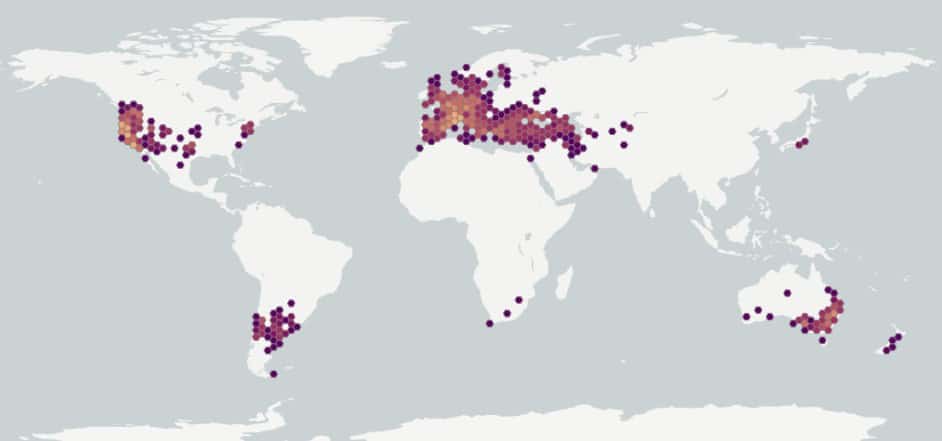Centaurea solstitialis
Overview
Aperçu
Regulation :
Remarques Réglementation:
- CFIA Weed Seeds Order - Class 1: Prohibited Noxious Weed Seeds
- List of Pests Regulated by Canada
- Quarantine lists of countries e.g. India *may be updated without notice
- USA Federal Noxious Weed Seed List
Regulation Notes:
Prohibited Noxious, Class 1 in the Canadian Weed Seeds Order (2016) under the Seeds Act. All imported and domestic seed must be free of Prohibited Noxious weed seeds.
Distribution :
Répartition :
Native to northern Africa, temperate Asia and Europe (USDA-ARS 2020). Introduced in other parts of Africa, Asia and Europe, as well as in North and South America, Australia, and New Zealand (CABI 2020; USDA-ARS 2020). Found in many U.S. states (USDA-NRCS 2020). No populations have persisted to date in Canada (CFIA 2014).
Habitat and Crop Association :
Habitat et Cultures Associées :
Pastures, rangelands, grasslands, and roadsides in dry areas (Maddox et al. 1985). Occasionally found as a weed of Medicago sativa (alfalfa) and grain crops but mainly a weed of rangelands (CABI 2020).
Economic Use, cultivation area, and Weed Association :
Utilisation économique, zone de culture et association de mauvaises herbes :
Duration of Life Cycle :
Durée du cycle vital:
Winter annual
Dispersal Unit Type :
Type d’unité de dispersion :
Achene
General Information
RENSEIGNEMENTS GÉNÉRAUX
Centaurea solstitialis was accidentally introduced into California during the Gold Rush era of the mid-1800s (DiTomaso and Healy 2007). The species is a problem in California with millions of hectares infested, and is spreading into Washington, Oregon and Idaho (CABI 2020).
C. solstitialis plants produce between 1000 – 10 000 achenes (Maddox et al. 1985) in a 3:1 ratio or 85% of the achene type with a pappus compared to achenes without a pappus (Callihan et al. 1993; Benefield et al. 2001). The achene type without a pappus retained viability longer than the type with a pappus (Callihan et al. 1993; Benefield et al. 2001).
The achenes are locally dispersed by the spiny fruit heads caught in animal fur and farm machinery, and contaminated crop seed is a risk for introduction into new areas (Zouhar 2002).
.

Centaurea solstitialis infestation (Steve Dewey, Utah State University, Bugwood.org)
Identification
Identification
-
Dimorphic Achene: achene with pappus
Size
- Achene length*: 2.1 – 2.9 mm; width: 1.0 – 1.4 mm
*Note: minimum and maximum of 10 achenes in a normal range of this species using image measurement (ISMA 2020)
Shape
- Oblong shaped achene with narrow, notched end and truncate end, laterally compressed
Surface Texture
- Achenes are smooth
Colour
- Achenes are shiny or glossy straw yellow with brown streaks; a light yellow coloured central stripe on each side of the achene
Other Features
Pappus
- Pappus length: 2.0 – 4.0 mm (FNA 1993+)
- Pappus is of white, flat bristles of varying lengths
Achene end with pappus
- A small style remnant is present in the center of the truncate end
- The rim around the truncate end with style remnant is glossy light yellow
Achene end without pappus
- The side notch at the end attached to the flower head is small and shallow compared to other similar Centaurea species
- Tissue (elaiosome) is generally present in the notch but may be removed during processing
- The area around the side notch is glossy light yellow

Yellow starthistle (Centaurea solstitialis) light achenes from inner florets and dark achenes from outer florets



-
Dimorphic Achene: achene without pappus
Size
- Achene length*: 1.8 – 2.4 mm; width: 1.0 – 1.3 mm
*Note: minimum and maximum of 10 achenes in a normal range of this species using image measurement (ISMA 2020)
Shape
- Oblong shaped achene with narrow, notched end and truncate end, laterally compressed
Surface Texture
- Achene surface is smooth
Colour
- Achene surface colour is generally dull dark brown with light yellow streaks
- Some achenes are dull reddish-brown with light yellow streaks, light yellow with brown streaks or solid brown coloured
Other Features
Pappus
- Achenes have no pappus attached
Achene end with pappus
- A small style remnant is present in the center of the truncate end
- The area around the style remnant is light yellow, the rim is generally the same colour as the achene body
Achene end without pappus
- The side notch is small and shallow compared to other Centaurea species
- Tissue (elaiosome) is generally present in the notch but may be removed during processing
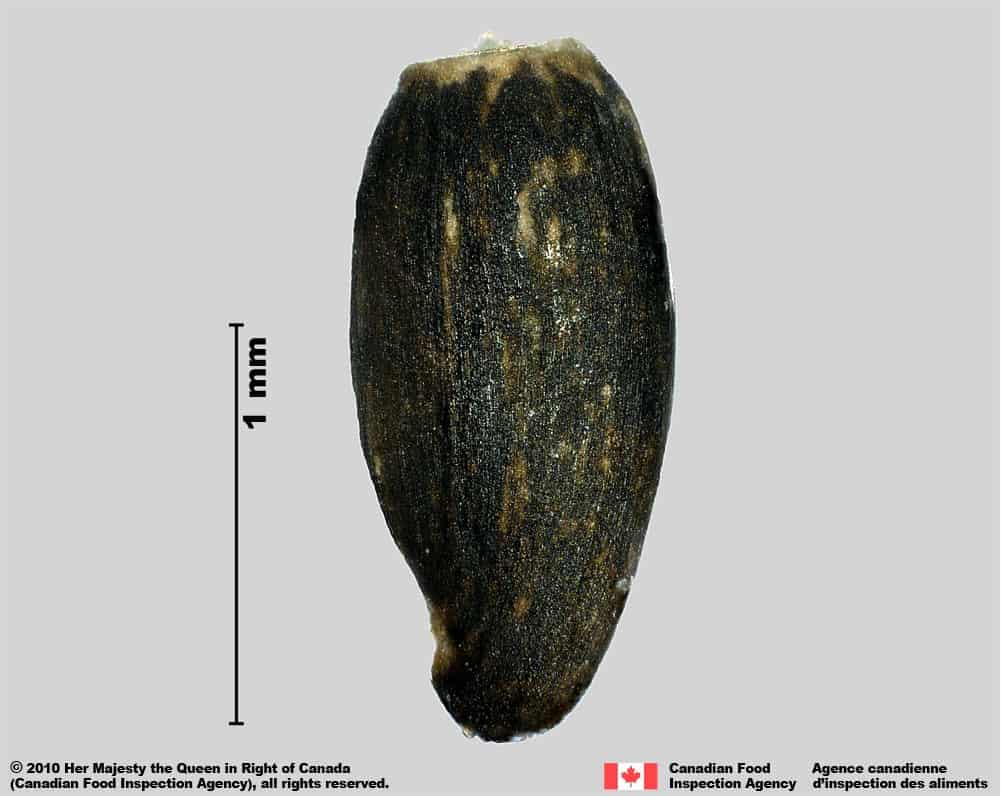
Yellow starthistle (Centaurea solstitialis) achene from outer florets; side view



-
Seed
Size
- Seed size similar to achene size
Shape
- Seed is oblong shaped
Surface Texture
- Seed surface is smooth
Colour
- Seed is orange or yellow
Other Features
- Seed coat light brown, adhering to fruit wall
-
Embryo
Size
- The embryo fills the seed
Shape
- Embryo is spatulate, axial position
Endosperm
- Endosperm absent, nutritive tissue stored in the cotyledons
Other Features
- Cotyledons are fleshy and soft-textured
Identification Tips
CONSEILS POUR L’IDENTIFICATION
The pappus of the commonly found achene type is longer than that of many other Centaurea species. The achene type without a pappus may be mistaken for another species of Centaurea rather than a dimorphic achene of the same species.

Yellow starthistle (Centaurea solstitialis) light achenes from inner florets and dark achenes from outer florets






Additional Botany Information
AUTRES RENSEIGNEMENTS BOTANIQUES
Flowers/Inflorescence
- Flower heads oval shaped, often with woolly hairs, flowers yellow (FNA 1993+)
Vegetative Features
- Involucral bracts are oval shaped, tipped with a long straw yellow spine, with shorter secondary spines clustered at the base
- The dull achenes have been observed to remain longer in the fruiting head than the glossy achenes, even over the winter months (Callihan et al. 1993)

Centaurea solstitialis plant in flower (Joseph M. DiTomaso, University of California – Davis, Bugwood.org)






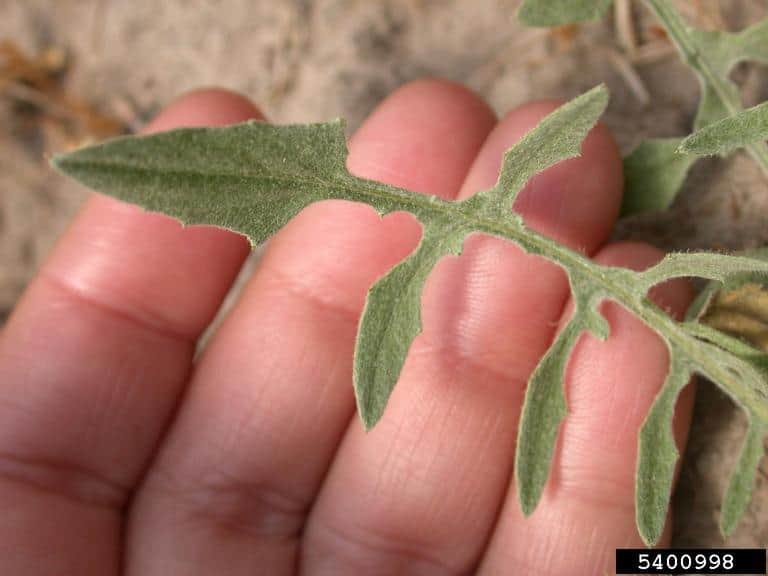
Similar Species
ESPÈCES SEMBLABLES
Similar species are based on a study of seed morphology of various species, and those with similar dispersal units are identified. The study is limited by physical specimen and literature availability at the time of examination, and possibly impacted by the subjectivity of the authors based on their knowledge and experience. Providing similar species information for seed identification is to make users aware of similarities that could possibly result in misidentification.
Centaurea melitensis L. (Malta knapweed)
C. melitensis achenes look similar to the C. solstitialis achene type with a pappus. C. melitensis achenes are generally smaller (length*: 1.8 – 2.8 mm; width: 0.8 – 1.3 mm) have a deep, hook-shaped side notch, a pappus with generally wider bristles, and are grey coloured compared to C. solstitialis achenes.
Centaurea calcitrapa L. (purple starthistle)
The achenes of C. calcitrapa look similar to the C. solstitialis achene type without a pappus. They are generally larger (length*: 2.4 – 3.0 mm; width: 1.3 – 1.7 mm) than C. solstitialis and may be brown coloured.
*Note: minimum and maximum of 10 achenes in a normal range of this species using image measurement (ISMA 2020)
Click to select species
Cliquez pour sélectionner les espèces
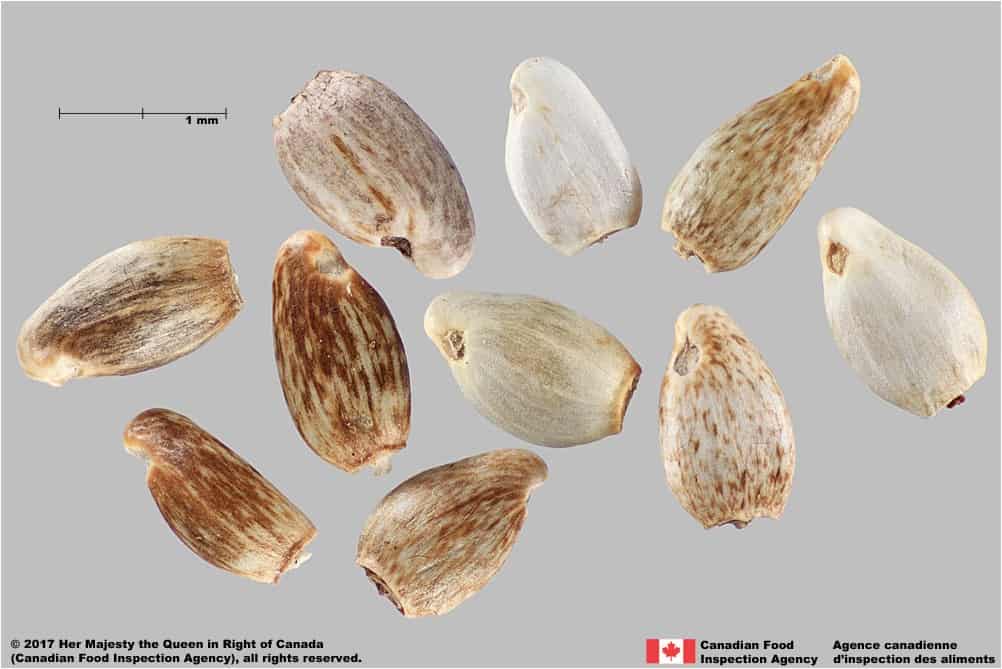
Centaurea calcitrapa

Centaurea melitensis
Comparison Window
Fenêtre de comparaison
MAIN SPECIES
ESPÈCES PRINCIPALES
Centaurea solstitialis

Centaurea solstitialis
Asteraceae
Yellow starthistle (Centaurea solstitialis) light achenes from inner florets and dark achenes from outer florets
MAIN SPECIES
ESPÈCES PRINCIPALES
Centaurea solstitialis

Centaurea solstitialis
Asteraceae
Yellow starthistle (Centaurea solstitialis) achenes from outer florets
MAIN SPECIES
ESPÈCES PRINCIPALES
Centaurea solstitialis

Centaurea solstitialis
Asteraceae
Yellow starthistle (Centaurea solstitialis) achene from inner florets
MAIN SPECIES
ESPÈCES PRINCIPALES
Centaurea solstitialis

Centaurea solstitialis
Asteraceae
Yellow starthistle (Centaurea solstitialis) achene from inner florets; top-down view
MAIN SPECIES
ESPÈCES PRINCIPALES
Centaurea solstitialis

Centaurea solstitialis
Asteraceae
Yellow starthistle (Centaurea solstitialis) achene from outer florets; side view
MAIN SPECIES
ESPÈCES PRINCIPALES
Centaurea solstitialis

Centaurea solstitialis
Asteraceae
Yellow starthistle (Centaurea solstitialis) achene from outer florets; top-down view
MAIN SPECIES
ESPÈCES PRINCIPALES
Centaurea solstitialis

Centaurea solstitialis
Asteraceae
Yellow star-thistle (Centaurea solstitialis) spiny bracts surrounding the flower head
SIMILAR SPECIES
ESPÈCES SEMBLABLES
Centaurea calcitrapa

Centaurea calcitrapa
Asteraceae
Purple starthistle (Centaurea calcitrapa) achenes
SIMILAR SPECIES
ESPÈCES SEMBLABLES
Centaurea calcitrapa
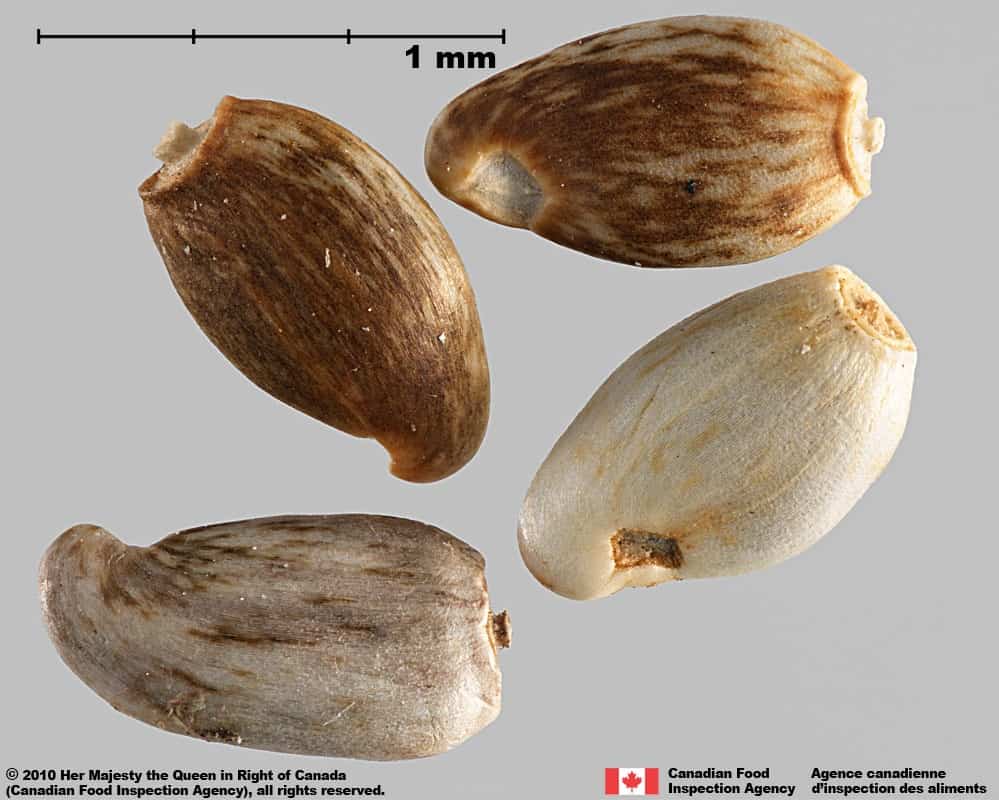
Centaurea calcitrapa
Asteraceae
Purple starthistle (Centaurea calcitrapa) achenes
SIMILAR SPECIES
ESPÈCES SEMBLABLES
Centaurea calcitrapa

Centaurea calcitrapa
Asteraceae
Purple starthistle (Centaurea calcitrapa) achene; side view
SIMILAR SPECIES
ESPÈCES SEMBLABLES
Centaurea calcitrapa
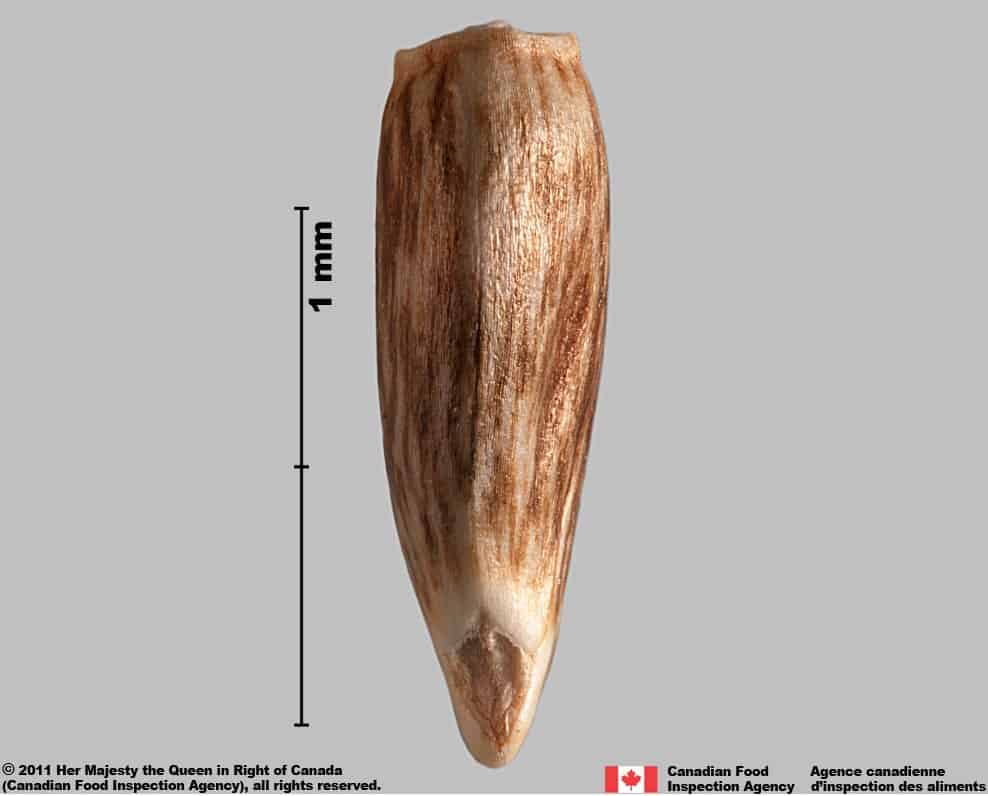
Centaurea calcitrapa
Asteraceae
Purple starthistle (Centaurea calcitrapa) achene
Need ID Help?
Besoin d’aide pour l’identification?
Reference(s)
Référence(s)
Benefield, C. B., DiTomaso, J. M., Kyser, G. B., Tschohl, A. 2001. Reproductive biology of yellow starthistle: maximizing late-season control. Weed Science. 49(1): 83-90.
Centre for Agriculture and Bioscience International (CABI). 2020. Invasive Species Compendium, CAB International, Wallingford, UK. https://www.cabidigitallibrary.org/journal/cabicompendium Accessed October 8, 2020.
Callihan, R. H., Prather, T. S. and Northam, F. E. 1993. Longevity of Yellow Starthistle (Centaurea solstitialis) achenes in soil. Weed Technology 7: 33-35.
Canadian Food Inspection Agency (CFIA). 2014. Invasive Plants – Fact Sheets. Ottawa, ON., http://www.inspection.gc.ca/plants/plant-pests-invasive-species/invasive-plants/fact-sheets/eng/1331614724083/1331614823132 Accessed November 23, 2020.
DiTomaso, J. M. and Healy, E. A. 2007. Weeds of California and Other Western States. Vol. 1. 834 pp. University of California, CA.
Flora of North America (FNA) Editorial Committee, eds. 1993+. Flora of North America North of Mexico [Online]. 22+ vols. New York and Oxford. http://beta.floranorthamerica.org. Accessed April 25, 2017.
Government of Canada (GC). 2016. Canadian Weed Seeds Order. https://laws-lois.justice.gc.ca/eng/regulations/SOR-2016-93/page-2.html (English) https://laws-lois.justice.gc.ca/fra/reglements/DORS-2016-93/page-2.html (French)
International Seed Morphology Association (ISMA). 2020. Method for Seed Size Measurement. Version 1.0. ISMA Publication Guide.
Maddox, D. M., Mayfield, A. and Poritz, N. H. 1985. Distribution of yellow starthistle (Centaurea solstitialis) and Russian knapweed (Centaurea repens). Weed Science 33: 315-327.
Parsons, W. T. and Cuthbertson, E. G. 1992. Noxious weeds of Australia Inkata Press, Melbourne, Australia.
Plants of the World Online (POWO) 2022. Facilitated by the Royal Botanic Gardens, Kew. Published on the Internet; http://www.plantsoftheworldonline.org/ Accessed April 29, 2022.
U.S. Department of Agriculture-Natural Resources Conservation Service (USDA-NRCS). 2020. The PLANTS Database. National Plant Data Team, Greensboro, NC USA. http://plants.usda.gov Accessed October 15, 2020.
Zouhar, K. 2002. Centaurea solstitialis. In: Fire Effects Information System, http://www.fs.fed.us/database/feis/plants/forb/censol/all.html Accessed October 15, 2020.




